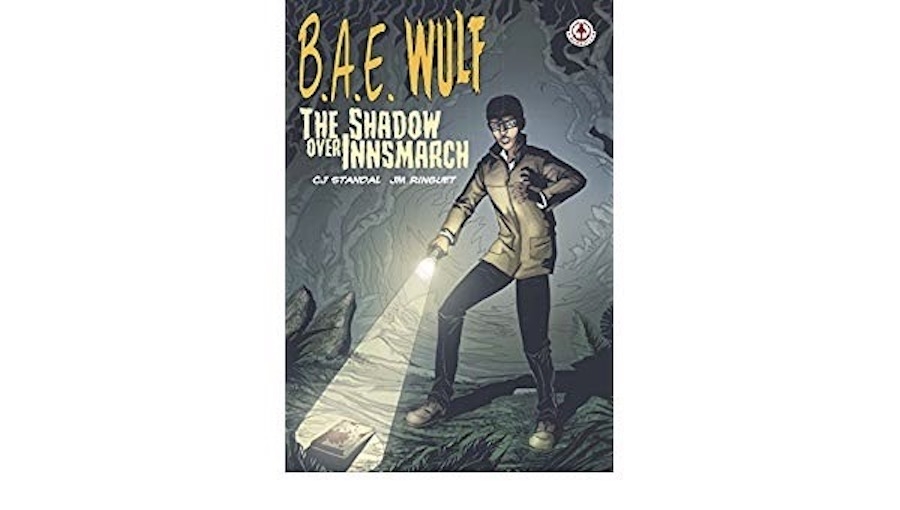B.A.E. Wulf: The Shadow Over Innsmarch is a new, long-form comic book that will release on March 2 from independent publisher Markosia Publishing. A mashup of an Old English epic poem about the hero Beowulf and H.P. Lovecraft stories, this is a modern-day tale about a disgraced journalist who – while investigating a series of crimes – learns that an island has been the locale for mysterious (occult) deaths. The journalist seeks answers in an old journal of a townsperson from a hundred years prior and finds that the events recorded decades earlier are eerily otherworldly and similar to what she witnesses during her investigation.
The creative team of B.A.E. Wulf is CJ Standal who wrote and lettered the story, while JM Ringuet provided pencils, inks, and color. Standal delivers a quickly paced story that keeps readers on the edge of their seats as they turn each page. The main character, Brenda Edmonton, is African-American and is a definite departure from the characters that typically inhabit Lovecraft’s tales. Instead, Standal balances the diversity of the characters portrayed, ensuring a more balanced use of and panel time of each character. As a person who has read many Lovecraftian-inspired tales, it was a relief that the Innsmarch people were not endowed with fish-like traits like so many of the Innsmouth locale stories, and that the monsters were based on, but different from, Lovecraft’s otherworldly creatures. Standal’s lettering is consistent and balanced; however, the font in the journal would have been easier to read if the lettering had been widened slightly.
Ringuet’s visuals engage the reader and assist in conveying the story that is being told. Particularly memorable are the opening panels that establish the location where Edmonton is headed in contrast to where she is from (i.e., the big city). Ringuet makes good use of the page space and mixes up the panel configurations, ensuring the visuals remain fresh and interesting. The color palette works well; the blues and greens deliver a somber mood, as well as highlight the rural environment of the island. The bright glow of the monster and moments when fires are present on the page really stand out well. In the third act, Ringuet channels Lovecraft’s familiar horror world when Edmonton wakes to find herself in a strange cave that isn’t manmade but isn’t exactly a product of nature either. This is not small feat; conveying Lovecraftian’s world is challenging, because the concept of absolute horror is necessarily limited by Lovecraft’s effort to build suspense and leave the reader to fill in the horror they “see.”
There were a few issues with B.A.E. Wulf. An editor would have caught the few instances of misspelled words, an error with character names, and could have tightened the journal narratives just a little bit. Also, pulling in more of Lovecraft’s suspense narrative beats in Edmonton’s exchange with the monster would have added to the quick pacing Standal established. The most jarring issue that takes the reader out of the moment is when the monster descriptions in the journal are not matched by the visuals. For example, the monster’s knees were inverted from how humans knees function, but that difference in anatomy was not visually conveyed. And the journal records the monster as having eyes and mouths. When the reader sees the monster, it does have mouths with the jagged teeth, but the eyes are missing.
The press release that accompanied this book states that B.A.E. Wulf will appeal to horror fans, but will also appeal “to people who support the #MeToo and #BlackLiveMatter movements.” This is an important point; this is why #StoriesMatter. While there is an ease of using an established world – the reader’s familiarity with that setting – it is also limiting and requires creativity and finesse. Standal and Ringuet challenge Lovecraft’s well-worn technique of one type of character (white male), proving that a diverse group of characters can successfully deliver an entertaining and scary Lovecraftian-inspired tale. Additionally, the inclusion of female and African-American characters opens up and invites diverse readership to associate and identify with any number of the characters, resulting in a more personal experience with the story. Also, Standal and Ringuet’s B.A.E. Wulf story adds to and expands the ever-evolving Lovecraftian mythos, delivering new characters and monsters. Their story will hopefully encourage other creators to think outside the proverbial box when working in Lovecraft’s literary toolbox.
Creative Team: CJ Standal (writer/letterer); JM Ringuet (penciller/inker/colorist)
Publisher: Markosia Publishing
Click here to purchase.

